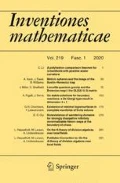Summary
New statistics on partitions (calledcranks) are defined which combinatorially prove Ramanujan's congruences for the partition function modulo 5, 7, 11, and 25. Explicit bijections are given for the equinumerous crank classes. The cranks are closely related to thet-core of a partition. Usingq-series, some explicit formulas are given for the number of partitions which aret-cores. Some related questions for self-conjugate and distinct partitions are discussed.
Similar content being viewed by others
References
Andrews, G.E.: The theory of partitions. Encyclopedia of Mathematics and Its Applications, Vol. 2. Rota, G.-C. (ed.), Reading, MA:, Addison-Wesley 1976 (reissued by Cambridge Univ. Press, London and New York, 1985)
Andrews, G.E.: Applications of basic hypergeometric functions SIAM Rev.16, 441–484 (1975)
Andrews, G.E., Garvan, F.G.: Dyson's crank of a partition. Bull. Am. Math. Soc.18, 167–171 (1988)
Atkin, A.O.L.: Proof of a conjecture of Ramanujan. Glasgow Math. J.8, 14–32 (1967)
Atkin, A.O.L., Swinnerton-Dyer, P.: Some properties of partitions. Proc. Lond. Math. Soc., III. Ser.4, 84–106 (1954)
Bailey, W.N.: A note on two of Ramanujan's formulae. Q. J. Math. Oxf. II. Ser.,3, 29–31 (1952)
Dyson, F.: Some guesses in the theory of partitions. Eureka (Cambridge),8, 10–15 (1944)
Fine, N.: On a system of modular functions connected with the Ramanujan identities. Tohoku Math. J.8, 149–164 (1956)
Garvan, F.: New combinatorial interpretations of Ramanujan's partition congruences mod 5, 7 and 11. Trans. Am. Math. Soc.305, 47–77 (1988)
Garvan, F.: The crank of partitions mod 8, 9 and 10. Preprint
Garvan, F., Stanton, D.: Sieved partition functions andq-binomial coefficients. Math. Comput. (to appear)
Hardy, G.H., Wright, E.M.: An Introduction to the Theory of Numbers. London: Oxford Univ. Press 1979
James, G., Kerber, A.: The Representation Theory of the Symmetric Group. Reading, MA: Addison-Wesley 1981
Koblitz, N.: Introduction to Elliptic Curves and Modular Forms. New York: Springer, 1984
Kolberg, O.: Some identities involving the partition function. Math. Scand5, 77–92, (1957)
Kolberg, O.: An elementary discussion of certain modular forms. Univ. Bergen Arb. naturv. r. Nr. 19. (1959)
Morris, A., Yaseen, K.: Some combinatorial results for shifted Young diagrams. Math. Proc. Camb. Philos. Soc.,99, 23–31 (1986)
Olsson, J.: Frobenius symbols for partitions and degrees of spin characters. Math. Scand.61, 223–247 (1987)
Ramanujan, S.: Collected Papers of S. Ramanujan. London, New York: Cambridge Univ. Press 1927 (reprinted by Chelsea, New York, 1962)
Watson, G.N.: Ramanujans Vermutung über Zerfällungsanzahlen. J. Reine Angew. Math.179, pp. 97–128 (1938)
Watson, G.N.: Proof of certain identities in combinatory analysis. J. Ind. Math. Soc.20, 57–69 (1933)
Author information
Authors and Affiliations
Additional information
This work was partially supported by NSF grant DMS: 8700995
Oblatum 16-IX-1989
Rights and permissions
About this article
Cite this article
Garvan, F., Kim, D. & Stanton, D. Cranks andt-cores. Invent Math 101, 1–17 (1990). https://doi.org/10.1007/BF01231493
Issue Date:
DOI: https://doi.org/10.1007/BF01231493



